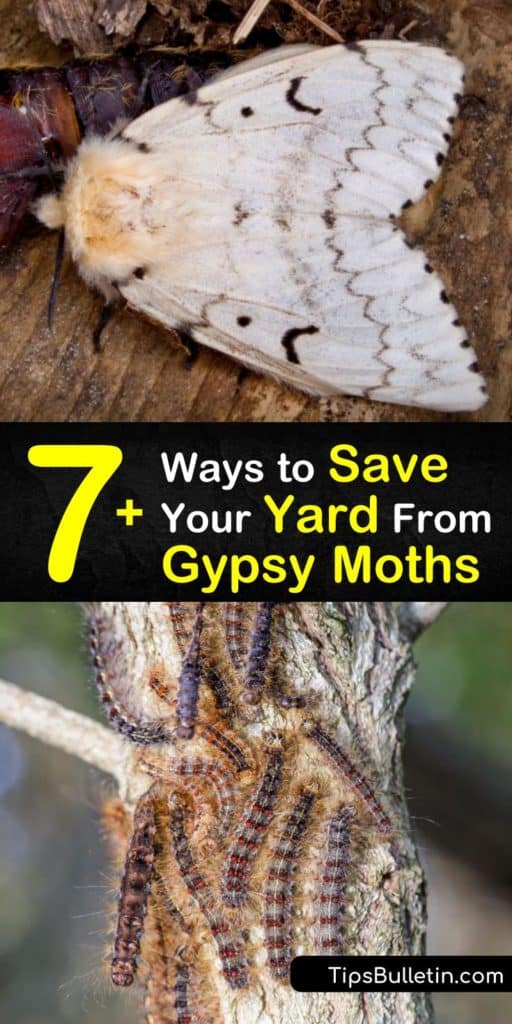Most of us worry about moth infestations inside our homes, but when it comes to gypsy moths, you don’t want to spot them outside your home at all. It’s essential to learn how to get rid of gypsy moths before turning into a gypsy moth caterpillar infestation.
If you spot one, it’s only a matter of time before defoliation happens to your favorite trees. Gypsy moth caterpillars made their first appearance in the United States in the 1800s for creating a new variety of silkworm in the silk industry.
There were adult gypsy moths that escaped, and soon, gypsy moth populations were present in Massachusetts and spread to the rest of the eastern United States. Although their numbers rise and fall, high population numbers damage thousands of acres of land. Gypsy moths start feasting on trees in the early spring.

Gypsy Moth Life Cycle
Although some trees can regrow another set of leaves, they only handle a few years of successive defoliation before dying. Defoliation compromises the tree’s resistance and makes it more prone to getting dangerous pests and diseases.
There are hundreds of types of moths, from those we find inside and others, outdoors. What attracts moths outside? Many moths are attracted to light, which draws their food sources.
Others prefer trees. Female gypsy moths lay egg masses up to 1,000 per adult moth. They lay eggs near sheltered areas like in woodpiles, inside dead branches and stumps, on tree trunks, or under the bark. Each gypsy moth egg hatches in late April, and they turn into caterpillars.
Gypsy moth larvae are unique compared to other caterpillar species. Gypsy moth caterpillars have five pairs of blue dots and six pairs of red dots along their backs.
Their bodies are dark and completely covered in hair. Older gypsy moth larvae reach about two inches long. Their larvae stage lasts roughly seven weeks. Once early summer hits, the larvae transition to their pupae stage, where they begin their transition into adult moths.
The pupae form a dark brown shell around their bodies and are regularly found in tree crevices near their host trees. The adult moths appear after roughly two weeks.

Identifying Gypsy Moths
A male gypsy moth is smaller than a female and has a one-and-a-half-inch wingspan. They are dark brown with feathery antennae.
The female moth is usually white or cream-colored and has a two-inch wingspan. Although the female is unable to fly, she still creates large numbers of added moths.
Ways to Stop a Gypsy Moth Caterpillar Infestation
Before you start trying to kill every caterpillar in your yard, there are some tricks for knowing the signs to look for when hunting down gypsy moths. You are more likely to find gypsy moths where there is a lot of vegetation.
Look around your garden and pay incredibly close attention to your trees. Don’t be surprised if you spot them in other parts of your property though, because they do tend to wander. Keep your eyes peeled for egg masses in all crevices of your yard’s trees.
Host trees include most deciduous trees like oak, aspen, apple, birch, and willow, but they also feed on evergreen trees when their food supplies are low. Once you’ve spotted the nest, you’re ready to set your gypsy moth trap.
Keep Your Yard Clean
The easiest way to prevent a gypsy moth caterpillar infestation is to keep your yard tidy. This cleanliness includes removing all discarded items from your yard like dead branches, tree limbs, and stumps. If you spot an egg mass, take immediate action to destroy it.
How to Kill Gypsy Moths With Traps
Gypsy moth traps are a smart and cheap way to stop a yard takeover. Most homemade traps include household items that you already have around your home.
Use the scissors to punch small holes around the top half of the plastic bottle, then cut four larger holes in the bottle that allow the moth to enter. Put the screwdriver on top of the cap and hammer it into the bottle to create a small hole.
Remove the bottle cap and string the twine through. Tie a knot in the twine on the cap’s underside and leave more twine dangling from the top. Fill the plastic bottle with a couple of inches of water and add a few drops of dish soap. Gently swirl the bottle.
Put on your rubber gloves and tape the pheromone strip to the cap’s underside and place the lid back on the bottle. Use the string hanging out to tie it to a tree where you’re suspicious of the activity or around several locations outside your home.
How to Get Rid of Gypsy Moths using Barrier Bands
Barrier bands are a great tool in your fight against gypsy moths. Brands like Tanglefoot barrier bands prevent the caterpillars from crawling up your trunks and having access to your tree’s canopy.
How to Use BTK
BTK, also called Bacillus thuringiensis kurstaki, is a natural microbe in soil. This microbe creates toxic proteins. It also kills silverfish, beetles, black flies, and mosquitos.
BTK breaks down an insect’s gut after ingestion and causes the insect to die from starvation and infection. Before using BTK, make sure you have the right kind for what specific insect you want to kill.
Follow the directions on the product packaging by adding it to a lawn sprayer. Spray large areas around your home and on your trees to prevent a gypsy moth caterpillar infestation.
Plant Trees that Attract Predators
Birds like blue jays and cuckoos are natural predators to gypsy moths and caterpillars. Planting plants around your yard that attract these birds is a smart way to implement pest control.
Some plants that attract these wildlife species are fruiting plants like holly, honeysuckle, and oak trees.
If you don’t want to plant more trees, it’s easy to attract birds with bird feeders and baths. If you put the right food out, you’re sure to attract some natural enemies of the gypsy moth.
Wrap Burlap around Your Trees
Wrapping a piece of burlap in a complete circle around your tree trunk is an easy DIY way to prevent caterpillars from reaching the canopy of your trees.
When the gypsy moth caterpillars grow, they start to look for foliage to eat. As they migrate up the trunk, the burlap band traps them, and they either fall off or get stuck in the burlap.
Wrap the burlap loosely around your tree trunk, so it looks slightly ruffled. The caterpillars congregate in all the folds and are then easily removable.
Store-Bought Solutions
Your local home and garden center is likely to have plenty of spray options for you to consider. One of our favorites is Bonide Thuricide. This spray is organic and efficient when learning how to kill gypsy moths.
Add four tablespoons of Thuricide to a gallon of water in a yard sprayer. Spray all your plants and trees and repeat every two weeks until the problem is fixed.
Horticultural oil is another product that is good at killing gypsy moth eggs. Look for gypsy moths around your property at the end of winter or early spring. The egg masses are often tan in color and an inch across.
When you find a nest, spray the eggs with horticultural oil when the weather reaches a consistent temperature of over 40°F. Saturate the eggs thoroughly to prevent them from hatching in the late spring.
Kill Eggs with Liquid Detergent
Liquid detergent is a useful tool around the home because it has many purposes. Use it to clean your pantry if you discover moths in pantry or, if you spot a nest of gypsy moth eggs, fill a small bowl with equal parts water and liquid detergent.
Scrape the eggs into the soapy water using a thin blade or plaster spatula. Make sure that no eggs fall on the ground, or you risk the chance that they hatch in the spring and start the problem all over again.
For clothes moths, use essential oils like cedarwood to keep moths out of closet spaces. They don’t like the smell.
Don’t be Afraid to Call Pest Control
Although it’s usually our last-ditch effort, pest control is a useful service for homeowners. In most cases, the homeowner can take care of a gypsy moth problem effectively.
Unfortunately, sometimes the infestation gets out of control, and there isn’t much we can do ourselves to stop it. If you’ve exhausted all your resources, don’t be afraid to bite the bullet and pay pest control to handle the situation.
Paying them the cost to handle it is often cheaper than replacing all of your dead landscaping from years of gypsy moth abuse.
Although moths are usually harmless, they are among the most significant pests when their population gets out of control.
Before you know it, you have an out of control infestation and are surrounded by dead plants that couldn’t withstand the damage year after year.
Don’t be afraid of gypsy moths, because once you know how to kill them, it’s easier to prevent moths from showing up at all.

If this article teaching you how to get rid of gypsy moths helped you stop an infestation, share these products for killing gypsy moths on Facebook and Pinterest.